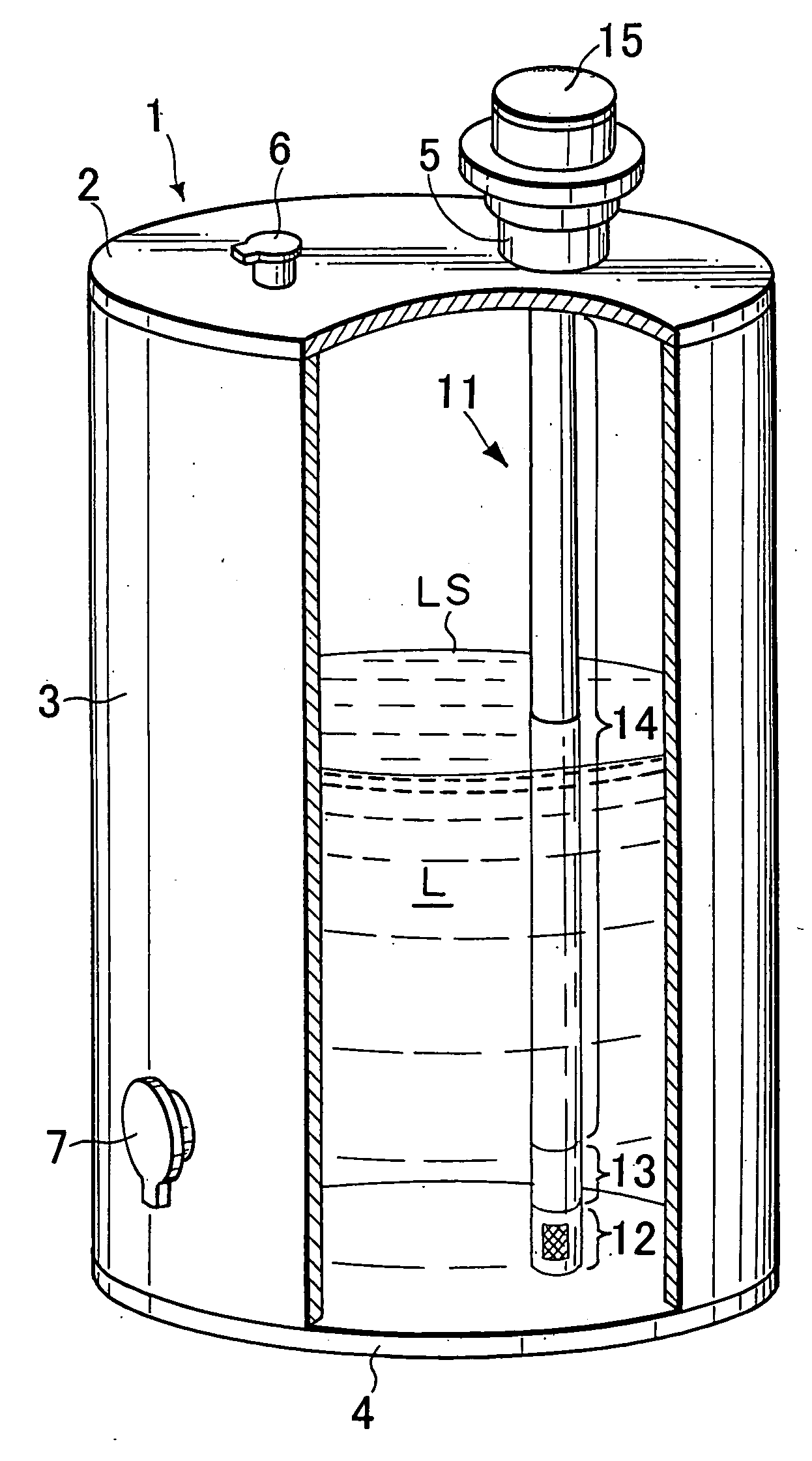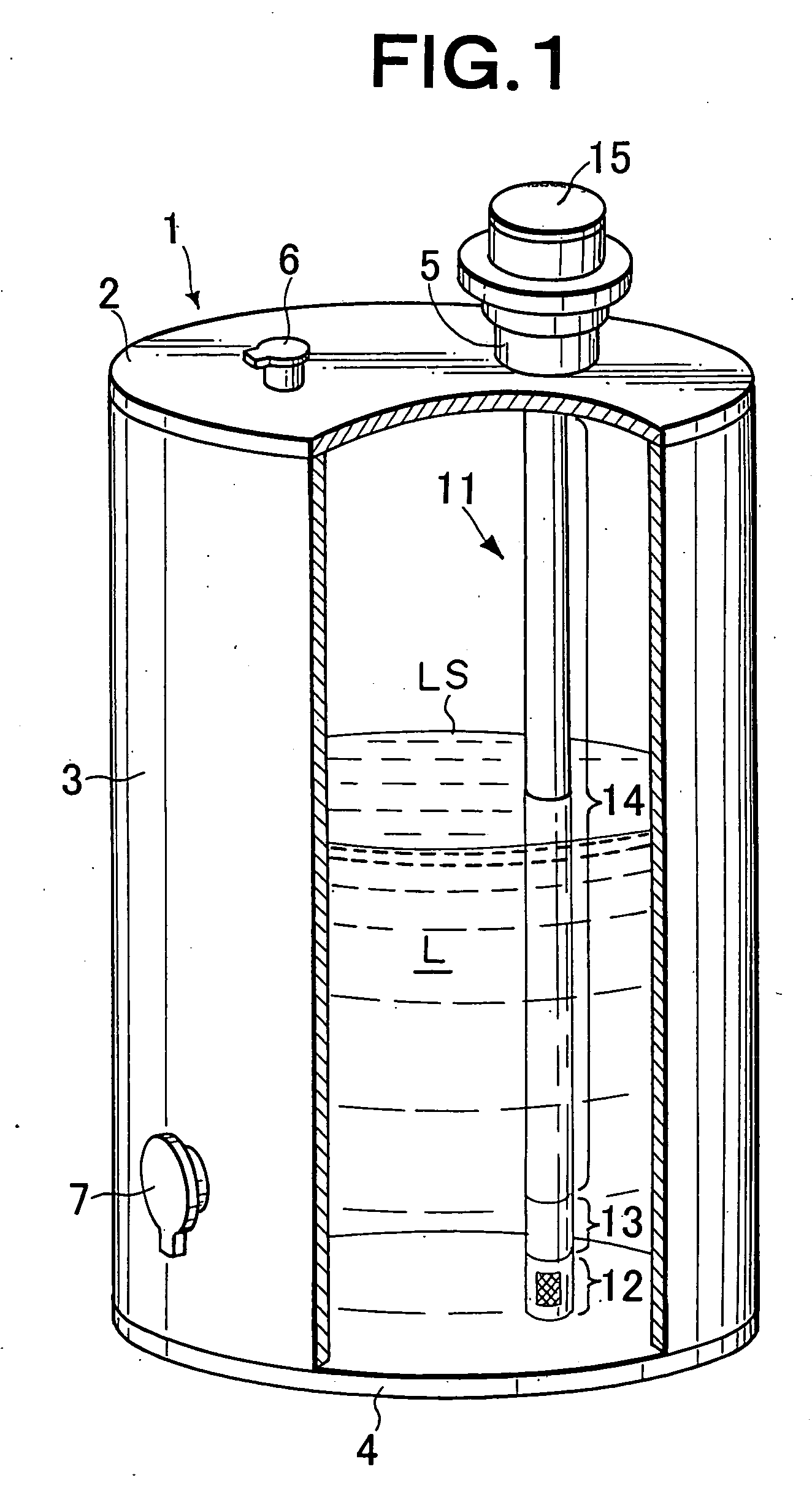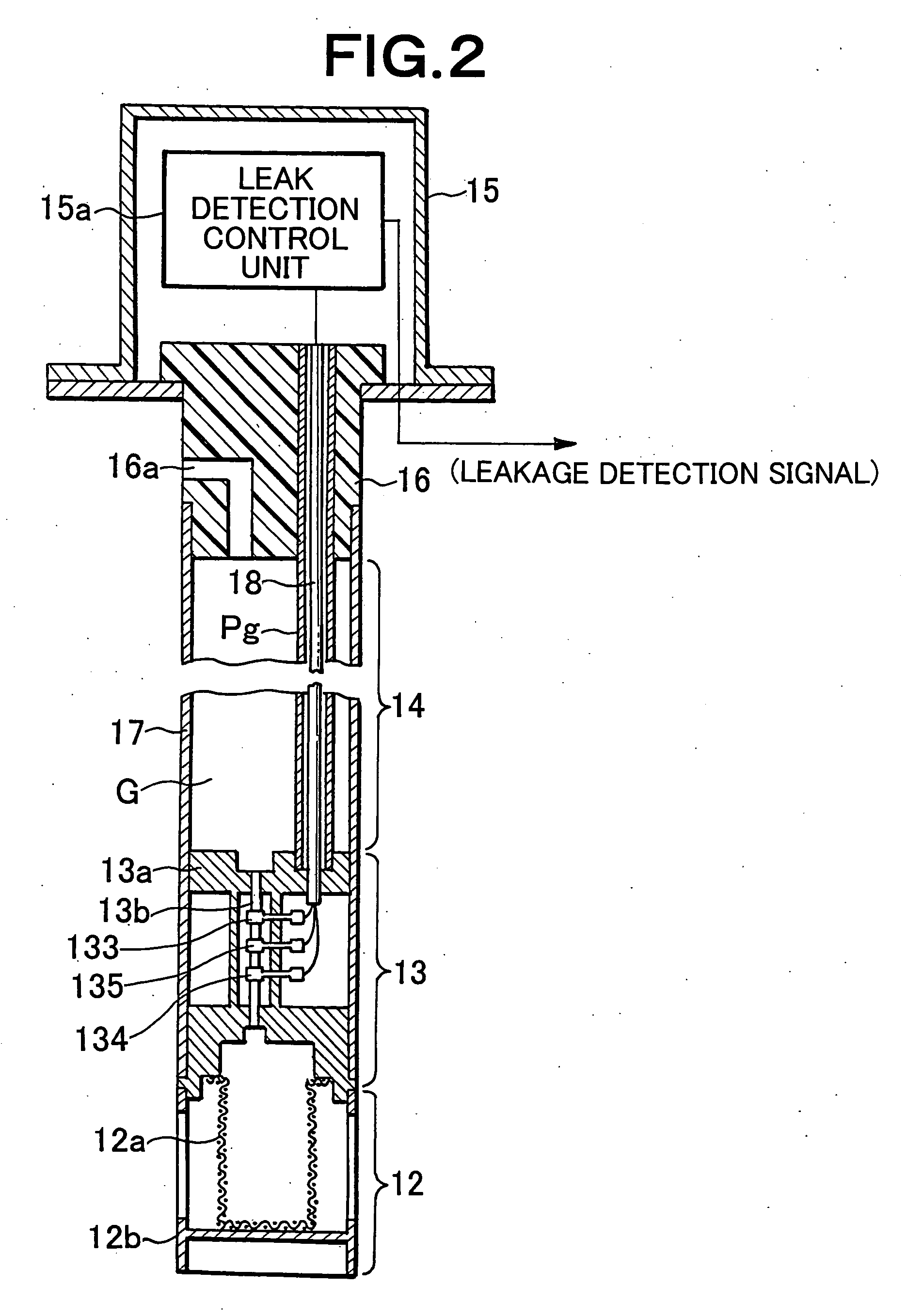[0055] In the present invention, the difference between the output of the leak detecting circuit and its initial value is integrated in response to the application of the
single pulse voltage to the heater which is performed by the
pulse voltage generating circuit to calculate the value equivalent to the flow rate of the liquid in the measuring slim-tube to thereby detect leakage of the liquid in the tank based on the calculated value. With this configuration, it is possible to perform leakage detection over a long period of time without stopping the use of the tank and reduce
power consumption. Therefore, it is possible to use a battery installed in the structural section of the
leak detector as a power source for the heater as well as to perform leakage detection over a long period of time without requiring battery replacement.
[0056] Further, in the present invention, the first leakage detection and the second leakage detection are performed. The first leakage detection uses the first temperature sensor, the heater and the second temperature sensor which are arranged this order along the measuring slim-tube and allows the heater to generate heat to detect leakage of the liquid in the tank based on the value equivalent to the liquid flow rate which is calculated by using the leak detecting circuit output corresponding to the difference between temperatures detected by the first and second temperature sensors. The second leakage detection detects leakage of the liquid in the tank based on the magnitude of the variation rate with respect to time of the liquid level which is measured by the
pressure sensor. In the case where the magnitude of the liquid level variation rate with respect to time falls within the predetermined range in the second leakage detection, the result of the second leakage detection is output. In the case where the magnitude of the liquid level variation rate with respect to time falls below the
lower limit of the predetermined range in the second leakage detection, the result of the first leakage detection is output. In the case where the magnitude of the liquid level variation rate with respect to time falls above the upper limit of the predetermined range in the second leakage detection, the output of the leakage detection
signal is stopped. With the above configuration, it is possible to accurately detect minute leakage, excluding an abrupt liquid level variation occurring when liquid is introduced into the tank from the outside or when liquid is supplied to the outside. Further, it is possible to detect leakage over a necessary and sufficient leakage amount range with higher accuracy.
[0057] When the pulse voltage generating circuit is used as the voltage generating circuit, the difference between the output of the leak detecting circuit and its initial value is integrated in response to the application of the single pulse voltage to the heater which is performed by the pulse voltage generating circuit to calculate the value equivalent to the flow rate of the liquid in the measuring slim-tube to thereby detect leakage of the liquid in the tank based on the calculated value. With this configuration, it is possible to perform leakage detection over a long period of time without stopping the use of the tank and reduce
power consumption. Therefore, it is possible to use a battery installed in the structural section of the leak
detector as a power source for the heater as well as to perform leakage detection over a long period of time without requiring battery replacement.
[0058] Further, in the present invention, the first temperature sensor, the heater and the second temperature sensor are arranged in this order along the measuring slim-tube and the heater is allowed to generate heat. The leak detecting circuit generates the output corresponding to the difference between temperatures detected by the first and second temperature sensors. The leak detecting circuit is used to detect the specific gravity of the liquid in the tank based on the value equivalent to the liquid flow rate which is calculated by using the output of the leak detecting circuit in the state where the on-off valve provided in the upper portion of the measuring tube connected to the upper end of the measuring slim-tube and having the sectional area larger than that thereof is closed. The specific gravity value obtained in the above detection is used to measure the liquid level by means of the
pressure sensor to thereby detect leakage of the liquid in the tank based on the magnitude of the liquid level variation rate with respect to time. With the above configuration, it is possible to increase accuracy in detecting leakage of the liquid in the tank based on the variation of the liquid level measured by the
pressure sensor irrespective of a value of the specific gravity of the liquid in the tank.
[0059] Further, in the present invention, the minute leakage detection detects leakage of the liquid in the tank based on the value equivalent to the liquid flow rate which is calculated by using the output of the leak detecting circuit in the state where the on-off valve is opened, and the leakage detection detects leakage of the liquid in the tank based on the magnitude of the variation rate with respect to time of the liquid level which is measured by the pressure sensor. In the case where the magnitude of the liquid level variation rate with respect to time falls within the predetermined range in the leakage detection, the result of the leakage detection is output. In the case where the magnitude of the liquid level variation rate with respect to time falls below the
lower limit of the predetermined range in the leakage detection, the result of the minute leakage detection is output. In the case where the magnitude of the liquid level variation rate with respect to time falls above the upper limit of the predetermined range in the leakage detection, the output of the leakage detection
signal is stopped. With the above configuration, it is possible to accurately detect minute leakage, excluding an abrupt liquid level variation occurring when liquid is introduced into the tank from the outside or when liquid is supplied to the outside. Further, it is possible to detect leakage over a necessary and sufficient leakage amount range with higher accuracy.
[0060] When the pulse voltage generating circuit is used as the voltage generating circuit, the difference between the output of the leak detecting circuit and its initial value is integrated in response to the application of the single pulse voltage to the heater which is performed by the pulse voltage generating circuit to calculate the value equivalent to the flow rate of the liquid in the measuring slim-tube to thereby detect leakage of the liquid in the tank based on the calculated value. With this configuration, it is possible to perform leakage detection over a long period of time without stopping the use of the tank and reduce
power consumption. Therefore, it is possible to use a battery installed in the structural section of the leak
detector as a power source for the heater as well as to perform leakage detection over a long period of time without requiring battery replacement.
 Login to View More
Login to View More  Login to View More
Login to View More 


